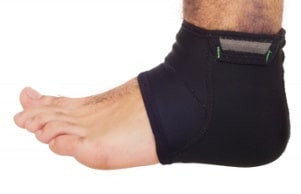What is Plantar Fasciitis?

You’ve probably heard a friend or relative complain of a painful condition called plantar fasciitis. Plantar fasciitis, or a ‘stone bruise’ is one of the most common causes of pain in the foot, heel and ankle, it affects millions of Americans each year.
But what is plantar fascitis?
Plantar fasciitis is a degeneration of the tissues forming the under surface of the foot, known as the sole. It can be caused by over-exertion, excessive weight bearing or obesity, standing for too long, ill-fitted shoes, high-heels, arthritis of the foot, gout and fracture. This may also be caused by genetics and simple mechanical problems of the foot itself. Hip, knee or lumbar problems can lead to heel pain due to excessive tension applied to the plantar fascia.
The first and most marked symptom of plantar fasciitis is pain. Heel pain typically starts suddenly and in the morning. The first steps after rising from the bed are excruciating and continued movement relieves the pain partially. Many patients experience continuous foot pain through the day. The pain is worse during any exertion like walking, running or jumping, and may be described as burning, pricking, dull aching, pulling, drawing or combinations of these. Pain may be localized to the bottom of the heel or may radiate to rest of the foot, however swelling and redness are minimal or absent. Left untreated, the pain gradually worsens.
The plantar fascia is a thick pad of tissue at its point of attachment to the heel bone. Due to the inflammatory and/or degenerative processes occurring in the plantar fascia, further thickening of the tissues is visible in a MRI scan of the foot. A faster and more cost-effective way to image the plantar fascia is with ultrasound. Some orthopedic surgeons are capable of performing this test for you. On examination, there is tenderness on the inner aspect of the heel where the plantar fascia attaches to the heel bone. Imaging, either MRI or ultrasound, will show a thickened and damaged fascia at the point of bony attachment. Sometimes there is fluid surrounding the plantar fascia as well.
An orthopedic doctor or surgeon can diagnose plantar fasciitis based on a detailed history and examination. Occasionally an x-ray may be used to help rule out an underlying hairline fracture of the heel, bone spur or any other unrelated cause of heel pain.
Treatment is based on pain relief and prevention. Ice packs give instant relief, while shoe inserts, orthotic wedges and insoles are also known to relieve the heel pain significantly. Tight fitted shoes and high heels should be avoided till the pain is gone. Painkillers like non-steroidal anti-inflammatory drugs and naproxen are the mainstay of medical management for heel pain. Physical therapy is a very effective remedy for plantar fasciitis and is safe and convenient for patients.
If these fail to give long-lasting or adequate relief, minor orthopedic surgery may be considered. In this case, an orthopedic surgeon will remove the excessive thickened tissue in the foot and sometimes may correct the shape of the foot to treat the pain. As recurrence is known widely, it is critical that patients strictly adhere to preventive foot care and daily exercises to stretch the foot for long term relief from plantar fascitis. Many home remedies for this problem exist and can be discussed with your doctor.
Image courtesy of artur84 / FreeDigitalPhotos.net
Dr. Meredith Warner is a board certified, Fellowship Trained Foot and Ankle, Orthopedic surgeon practicing in Baton Rouge, Louisiana. Dr. Warner is committed to offering her patients an accurate diagnosis along with a comprehensive treatment plan in order to get them back to a pain free life. Dr. Meredith Warner specializes in the treatment of orthopedic issues, providing operative and non-operative treatment plans of orthopedic problems, including musculoskeletal pain such as chronic back, neck and foot pain, reconstructive surgery of the foot and ankle, arthritis, diabetic, hammer toe, bunion, wound care, work injuries, fitness and nutrition and osteoporosis issues.
{{cta(‘bb456f31-3aff-4ca0-a458-b217882fde1b’)}}




